Patagonia Women's Nano-Air Hoody
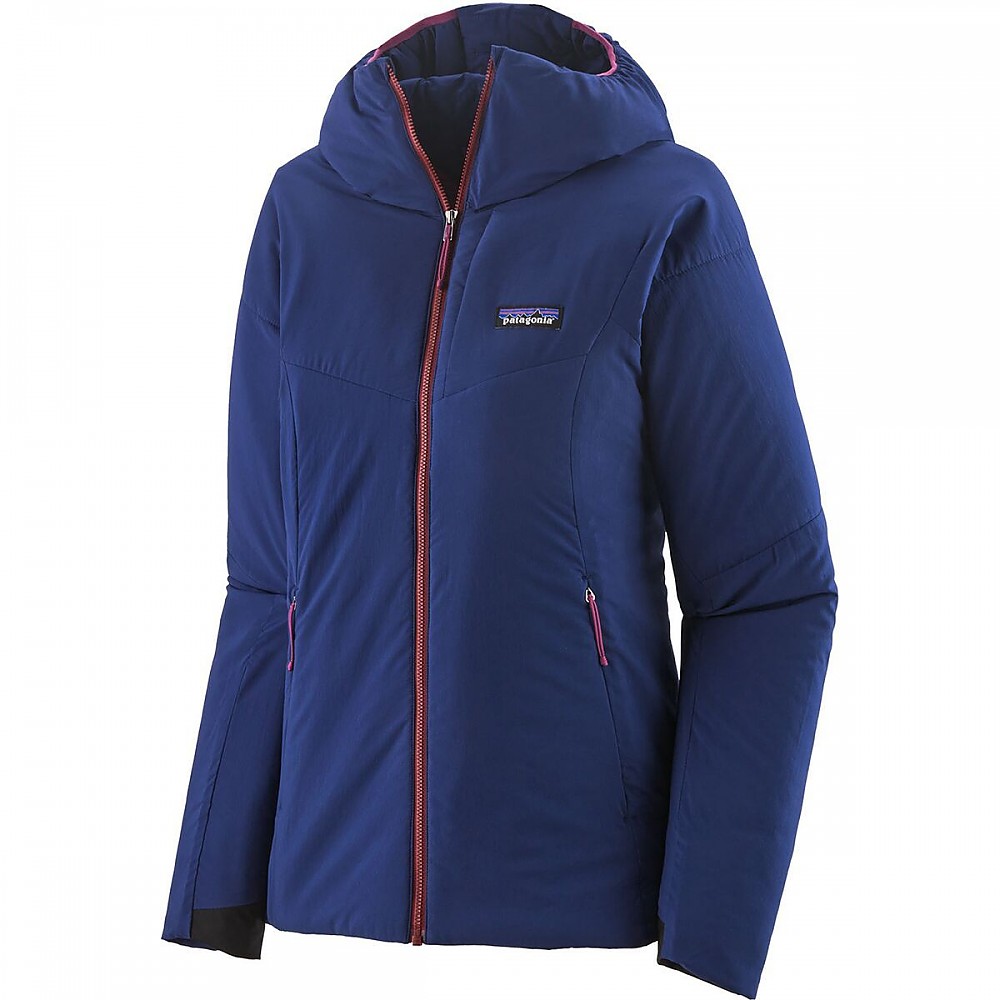
If you are a serious four-season outdoor junkie, consider using this jacket. It hits a perfect sweet spot: (from the company) “From trailhead to summit and back, the Nano-Air Hoody sets a new standard for technical insulation, merging the comfort and breathability of open fleece with the protection and warmth of a puffy.”
Honestly, I put this jacket on, and hardly have taken it off since I received it for testing. This jacket is the most comfortable and versatile garment I have ever worn. And the jacket only gets better from there.
The coat was designed around the climbing/alpine crowd, but I have found this coat is the perfect layering piece for one's favorite outdoor pursuit.
Pros
- Breathable, yet warm
- Stretchy
- Light
- Warm
- Good pocket placement
- Sheds light moisture
- Comfortable!
- Perfect layering garment
Cons
- Expensive
- Fabric pills
- Does not pack small
- Hood is not adjustible
- Hood does not accomodate helmets
Patagonia designed this jacket as part of a whole coat system. They were aiming at replacing fleece, and their “put it on and leave it on” mentality. Hence, Nano-Air has a slimmer profile intending it to be layered under its Nano Puff. As part of a layer system, the Nano-Air has high breathability making it a great outer layer as long as it isn’t too windy.
Thus, it can stand alone in light moisture in temp ranges of 30-60 degrees in light breezes, and it functions as a perfect mid-layer piece in higher precip, lower temps, or high winds with an over-layer.
I gave it four stars because 1) it is an expensive garment, and 2) the jacket is starting to pill in high-rub places.
I don’t normally include SO much from a distributer’s website, but I cannot outline the specs any more accurately than they did. The info is spot on (and we all know that manufactures can “stretch” the strengths of their gear. Not so, this time.)
From Patagonia:
… Its exclusive, supremely stretchy and breathable fabric package combines a plain-weave liner, warm-when-wet FullRange™ insulation and a lightweight-yet-durable, weather-shedding 100% nylon ripstop shell with DWR (durable water repellent) finish. The Hoody has an incredibly soft, supple feel and full mechanical stretch (without moisture-holding spandex) that allows for a close, femininely sculpted fit over baselayers and an uninhibited range of motion. At chilly belays or in frigid conditions, pull on a lightweight shell and the Nano-Air’s thermal properties skyrocket. The trim, stretchy hood is designed for next-to-noggin use, though it’ll still fit snugly over low-profile helmets. Two above-harness handwarmer pockets and two smaller chest pockets all close with trim, low-bulk zippers. The center-front zipper has a storm flap and zipper garage, while stretch binding at the cuffs and a dual-adjustable drawcord hem seal in warmth.
The Specs from the company:
- Light-yet-durable 100% nylon ripstop shell and plain-weave liner offer generous mechanical stretch and exceptional breathability, with a DWR (durable water repellent) finish
- Revolutionary 60-g FullRange™ Insulation warms and stretches; combined with the shell and liner, this creates a jacket with generous mechanical stretch and unprecedented air permeability (40CFM)
- Iconic Nano Puff® brick quilting in the side panels, articulated patterning and other quilting details improve shape and durability
- Stretchy hood with binding easily pulls on or off, even when jacket is zipped
- Center-front zipper has wicking interior storm flap and zipper garage at chin for next-to-skin comfort
- Two handwarmer pockets and two chest pockets are zippered, welted and low-bulk to wear comfortably with a harness or pack
- Stretch binding at the cuffs and a dual-adjustable drawcord hem seal in warmth
- Shell: 1.3-oz 20-denier 100% nylon ripstop. Lining: 2-oz 50-denier 100% nylon plain weave. Both shell and lining with mechanical stretch and a DWR (durable water repellent) finish. Insulation: 60-g FullRange™ 100% polyester stretch insulation
- 334 g (11.8 oz)
- Made in Vietnam.
Honestly, the jacket really does live up to the manufacturer claims, but at a pretty steep price.
Fit & Comfort
I LIVE in this jacket! It’s the one I ALWAYS reach for!
This test jacket is a medium, and I felt like it was a perfect fit for me at 5'4". I had my daughters and their friend try on the jacket. At 5’7” and 5’8” the jacket fitted each of their frames very well. My middle daughter lives and breathes climbing, and has a +2 reach. The sleeves were great on her 5'7" frame.
5'7" with +2 arm length
Many jackets “bunch” while worn under packs, etc. This jacket does not ever really “ride” up under the pack. If a garment is going to ride up, it will do it while on crutches! I included a picture of me on crutches while wearing the jacket. The jacket NEVER clumped or bunched under my arms.
Commiserating about our crutches. The jacket never rode up under my arms.
What’s really amazing about the jacket is in how it rode against my body. It became almost a second “skin”. I never had it pooch or gap under a pack, never needing to tug the collar or hem down. The only time I had to pull my garments down is when my base layer shirt would ride up over my slippery boarding pants.
This coat is almost “anti-friction” in the way it moves with the natural motion of the wearer, regardless of the activity.
The jacket moved very naturally with her.
Patagonia designed this coat from the inside out, and it shows.
Adjustability
The coat has just one size adjustment, and this is around the hips. The coat features two snug points near the inside of the jacket. I haven’t needed to use this feature
Water Resistance
The jacket’s DWR works perfectly in light rain and snow.
The only time I really had the coat wet out is when I was wearing the jacket while I was installing chains on my car in the pouring snow, and the cuffs rubbed all over the wet tires. (The cable was all twisted up, which prolonged installing the cables.) The water did soak all the way through the sleeves, but took about 15 minutes to dry once I got back into the warm car.
An hour in a pouring snowstorm was a good test for the hood and shoulders. They did get damp while installing the chains, but the water did not soak through at those points. The outer jacket dried quite quickly. The only part that stayed damp was at the neck where my cotton tee got wet before I put the hood up. The jacket and synthetic layer prohibited drying the cotton somewhat.
Most importantly, I NEVER felt cold or wet, even after eventually spending an hour fixing my chains, and helping another couple who had never installed chains on a car.
Breathability
The jacket shines here. I have worn this coat in temps from 15 degrees to 60 degrees. As long as the wind is not whipping at the lower temps, I stay comfortable in the coat.
In most of my other outdoor garments, I find that I am often adjusting them to regulate my temperature during the cycle of activity and rest. I really don't do that much with this jacket.
I am able to work hard in the jacket. If I get a bit warm, I unzip it. But, most of the time I find that when I put it on, I totally forget that I am wearing it.
The coat works great in mid-autumn temps, and I really don’t need to take the coat off when I am being active.
It’s also the perfect mid-layer piece.
On an 8-mile snowshoe trip, with the temps in the mid-20’s, the Nano-Air was a fantastic layering piece. I often feel over-warm when I layer, only to zip/unzip or even peel a layer to adjust — and I never really did any of that during the day. The only time I made an adjustment was to put the hood up for a while when we walked through a “cold-sink”.
Moisture
I never really feel overheated in the jacket. The fabric has never felt sticky or tacky against me. In fact, a couple times I needed to throw the jacket on all by itself, and the material felt so soft and comfy, I didn’t want to have to put other clothes on.
But the wicking and breathing is the very reason Patagonia designed this jacket. I am honestly impressed at how amazing this coat is at handling the warming/cooling cycle as I go about my activities.
Layered perfectly, the jacket never rode up under the life vest
Warmth
I went for a five-mile training hike in 22 degree temps wearing this jacket as the only outer layer, but I had a pack over it. I found that the jacket was *not quite* enough as the wind picked up a bit, and we were often in the shade. It wasn’t unbearable, but I did get pretty chilly when I stopped moving.
It was a high of about 22 this day. Jacket was great unless the wind picked up at that temp.
The only times I have found myself reaching for an outer jacket is when the temps dip into the 30’s or so.
As a stand-alone outer layer, it works best in the 30’s to 60’s range, sans big winds.
Layering
The jacket, while a bit “puffy” by design, really does layer well with other garments. The medium gives me enough room to wear a layer or two beneath, and the nylon outer fabric allows the jacket to be worn under other coats.
I have an OR soft shell that I favor for mid-winter sports, and the sleeves have a fleece liner. The jacket never bunched up or hung up on the fleece liner. I truly forgot I was wearing the jacket.
The picture shows how the outer coat rode up, not the Nano-Air.
What amazes me about the versatility of this coat is I have worn it when it was 30 degrees outside, come into a 68 degree room, and didn’t think about taking it off.
As mentioned, I was out in the pouring snow and 27 degree weather for an hour. I jumped in the car, which was VERY warm, and never felt overheated. Later, we stopped for dinner, and I was comfortable in the cool restaurant.
I think Patagonia installed a temperature Genie in a hidden pocket — truly, I have never had a garment that “self-adjusted” to the ambient temperature—in fact, I didn’t think it would be possible for a coat to be so effective at coping with such a large temperature range.
Abrasion
I have to give the coat a serious downtick here. I think Patagonia needs to find a way to make the shell fabric more durable while maintaining the integrity of the purpose of the coat.
Nylon is notorious for abrading, so I have kept an eye out for this issue. I have found that the fabric has not snagged or abraded as much as I am finding places where the fabric is starting to pill.
Pilling is happening on the front hem, inside and out.
Since climbers are an important target group, I could see where the rubbing and sliding on rocks all day could really contribute to pilling of the fabric.
Function
The pockets were really comfortable, warm, and well designed. Not only do my hands fit naturally in the pockets but the weight does not make the fabric pull while resting my hands in the coat.
I never lose things out of them, either.
Both sets of pockets are intentionally designed to be accessible while wearing a pack or harness, and they are.
I put my hands in my pockets A LOT. No real pull or breakdown of the fabric.
One of my favorite features of the chest pockets is how much they hold, and the contents manage to not look all bulgy and bulky in them. The pockets are big enough to hold my reader glasses and wallet, or my iPhone, etc. I LOVE having fingertip access to my glasses, and not worrying about having them get smashed.
The only consideration is remembering which chest pocket has contents, because the seat belt rubbing against the contents is annoying in the car.
The zippers of the pockets work perfectly, but because the fabric is SO stretchy, I find I have to hold the hem of the jacket when zipping the pockets closed.
The jacket does not compress down super small, but I can fit it comfortably into a 1 gallon zip-top baggie.
It packs to about 8x9x4".
Ease of Use
The fabric of the jacket has done a couple of serendipitously wonderful things that I did not expect. I find that even though I have nearly been living in the coat, the sleeves are quite clean. Often the hem of the sleeves will get rather “lived in” and gnarly. The combo of design, fabric and DWR has really helped to keep the “yuk” factor down on the hems/sleeves.
I am surprised at how "clean" the cuffs are with all the use I give this coat—left intentionally unwashed for this review.
Also, because I have really used the jacket, I was expecting that “exercise” order to linger. Nothing. No smell. I even had my husband test the smell factor. He couldn’t smell the odor factor, either. I was really surprised that after several weeks of use, all we both could sense was a typical fabric odor.
The only negative feature that grabbed my attention is that I found that the chest zipper caught from time to time. I think much of that factor goes back to the high four-way stretch this garment has, and the catching is more user-error than design flaw.
Features:
The multi-sport application of this jacket is one of its best features. The fabric truly does “adjust” to the activity level of the wearer. I’ve paddled, hiked, snowshoed, and biked wearing this jacket. It holds up to Patagonia’s claims of what it is made to do.


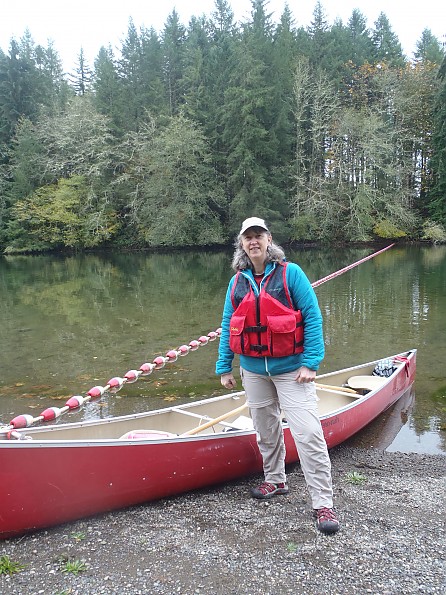

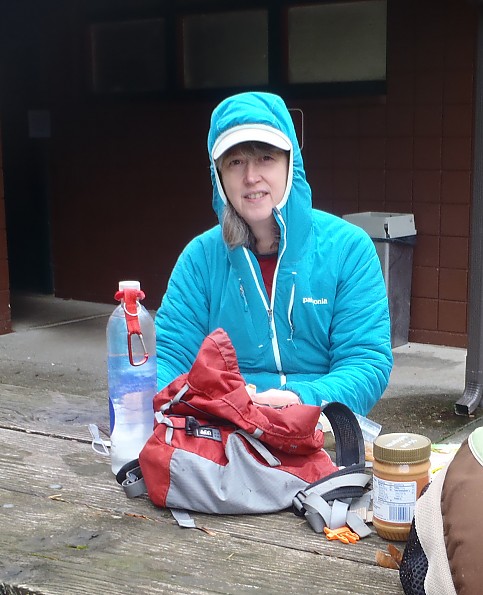
This coat will keep up with whatever grass you don't let grow under your feet.
The hood is not really designed to cover helmets. I find the hood too big for my small head without a brimmed hat or knit cap beneath.
The hood has no adjustments, and kept falling into my eyes.
I also tried a bike helmet and multi-sport helmet under the hood for comparison.
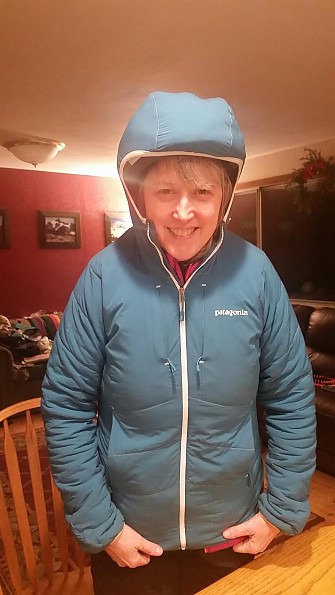
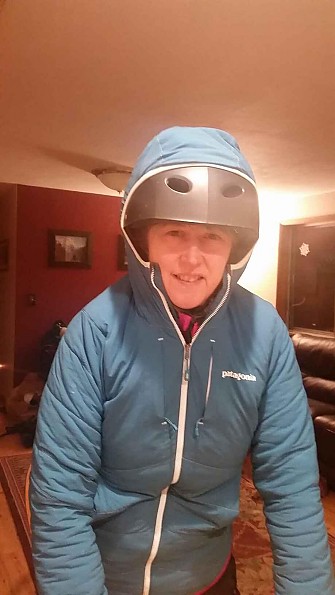
The jacket admits that there's room just for a small helmet — I put bike and multisport helmets on for comparison.
The Nano-Air more than lives up to its expectations.
Construction & Durability
The coat is very well made. I have been watching for thread-fraying, hem pulling, fabric thinning, and other high-wear signs.
As noted earlier, the only issue of note is the pilling.
Inner hem
Everything else about the coat reflects the quality and design that Patagonia stands for.
Conditions
I have used this in the Pacific Northwest, during the fall and early winter for three months.
I really love the quality and warmth of the Nano-Air. The piece is comfortable and effective hitting that sweet spot they targeted.
This is a quality garment. I strongly recommend this coat if it’s in your budget.
Source: received for testing via the Trailspace Review Corps
(Sample provided by Patagonia for testing and review)
I love how comfy and versatile this jacket is, but hate how poorly it has held up.
Pros
- Comfort
- Warmth
Cons
- Durability
This jacket is super comfy, both for hiking and skiing as well as lounging at home. It is the warm layer that I always want to wear.
I bought it to replace a light down jacket and have found that it is closer in warmth to my Patagonia R2 Jacket and that I choose one or the other for outdoor excursions. I think that the biggest bonus over an R2 is that it moves more moisture away from my back so I'm not quite as cold when I stop moving.
The main downside is that it has help up very poorly to use. I have used my R2 heavily for six years and it barely shows it. My Nano-Air has been in heavy rotation for only a year now and it shows signs of abrasion in many places and is pretty stained. The matte fabric picks up stains like no other! I have even taken the precaution of always washing it in a delicates bag and that hasn't seemed to help.
I still love wearing it and it still functions, but it looks pretty bad. I would suggest buying a dark color and not using it for abrasive activities such as climbing or bushwacking.
Source: bought it new
![]() All Nano-Air Hoody versions
All Nano-Air Hoody versions
In addition to the 2 women's reviews above, there are 2 reviews for other versions of the Nano-Air Hoody. Read all reviews »
Your Review
Where to Buy
You May Like
Specs
| Price |
MSRP: $299.00 Current Retail: $329.00 Historic Range: $129.06-$329.00 |
| Weight |
289 g / 10.2 oz |
| Insulation |
60-g FullRange 100% polyester (40% recycled) with four-way stretch |
|
Fabric is certified as bluesign approved |
















